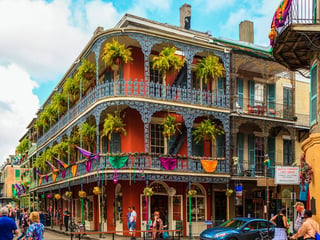Experience a tour of Louisiana's swamps
One of the highlights of any trip to Louisiana is exploring its swamps. The Bayou State is renowned for its unique Cajun culture and provides the opportunity for a close-up look at these mysterious wetlands in unspoiled, remote regions, where you’ll be mesmerised by the Spanish moss that drips across gnarled cypress trees. They’re filled with all sorts of wildlife that can be glimpsed, from alligators, turtles and wild boar to beautiful giant cranes and a host of magnificent bird species. Taking a tour brings the chance to learn about the legends of swamp monsters and the pirates that once hid among this wild landscape as well.
If that sounds like your kind of adventure, these Louisiana swamps are sure to fascinate.

Lake Fausse state park in Atchafalaya Basin
The Atchafalaya Basin is America’s largest swamp, providing freshwater for a wide swath of southern Louisiana. At its heart is the Lake Fausse Pointe State Park, which offers an outstanding introduction into the wetlands of Cajun country.
Visiting the park and the wetlands is easily done on foot with the pathways of boardwalks that will keep your feet dry as you trek across the elevated walkways that wind through stands of cypress trees providing views of the lake and adjacent Dauterive Lake. If you want to know more about what you’re witnessing, park naturalists are there to help you delve into the basin’s biology, ecology and history. In fact, its history alone attracts many to this park as it was once occupied by the Chitimacha Indians, the Spanish, French and the Acadians who arrived from Canada, better known today as the Cajuns.
You can get a more intimate look at the waterlogged forests by renting a kayak or canoe at the visitor center in the park, paddling the water trail to better understand what it was like here thousands of years ago. Airboat tours are also available from the Atchafalaya Basin Landing & Marina in Henderson, with captains who live right here on the water narrating the fascinating swamp excursions.
If you pick up a few groceries beforehand, afterwards fill your appetite by enjoying a picnic or grilling out underneath the impressive canopies.

Honey Island Swamp
Honey Island Swamp is just over a 30-minute drive from New Orleans and is considered one of America’s most pristine, least-altered river swamps. The 250-square-mile area is one of the best to tour in the state, with its incredible scenery, flora and fauna. Here you’ll have the opportunity to witness all sorts of waterfowl, mink, beaver, turtles, wild boar, and, of course, the toothy alligator. While the locals say there’s no need to fear the gators, they do say the infamous Honey Island Swamp Monster, the state’s own version of Bigfoot, is something to be on the lookout for.
Visitors can choose from swamp boat (covered or uncovered), airboat, kayak and canoe tours. Smaller vessels allow for access deep into the interior of the swamp and shallow backwater areas, though many can even be explored on foot.
Jean Lafitte swamp
Jean Lafitte Swamp, located with Jean Lafitte National Historical Park and Preserve, is truly unlike any other place in North America. It protects and preserves the unique heritage of the Cajun people along with the maze of waterways and untamed land that makes up the Mississippi Delta, just over 20 miles south of New Orleans.
Here you can come face-to-face with a variety of exotic plant life and wildlife as well as delve into the history and culture of the region in six separate sites, including the 23,000-acre Barataria Preserve with its wetlands inhabited by hundreds of bird species, alligators and wildflowers. Head out on your own and take a cellphone tour along the boardwalks and trails to view all the flora and fauna or join a pontoon boat tour of the preserve that brings visitors through the murky, meandering swamp waters.

Bonnet Carre spillway
If you’re looking for something different, the Bonnet Carre Spillway in St. Charles Parish offers a unique way to tour a swamp: in an all-terrain vehicle. You’ll be able to explore the 7,600-acre spillway, which is actually a flood control operation which allows the Mississippi floodwaters to flow into Lake Pontchartrain and into the Gulf of Mexico, situated about 12 miles west of New Orleans. You’ll strap on a helmet and enjoy an action-packed ride in a powerful ATV travelling through over 40 miles of swampland trails in this unique southern Louisiana ecosystem, encountering a wide range of indigenous plants and wildlife along the way.
Maurepas swamp wildlife management area
Some 25 miles west of New Orleans is the Maurepas Swamp Wildlife Management Area, which covers nearly 100 square miles. The refuge is primarily made up of cypress swampland that houses alligators, raccoons, rabbits, nutria and white-tailed deer. The waters also offer habitat for perch, largemouth bass and crappie, while the skies and trees are filled with bald eagles from late fall to early spring. The swamp has been marked as an ‘Important Bird Area’ by the National Audubon Society, with the opportunity to watch for great egret, snowy egret, great blue heron, tri-coloured heron, white ibis, and more which are often spotted among the alligator weed and bulltongue along the edges of the bayou.
One of the most popular ways to tour this area is via kayak, where you’ll paddle through the Maurepas swamps, starting with a presentation about the state’s threatened wetlands in New Orleans. Nighttime is the most popular time to embark on a tandem canoe excursion, with only the light of the moon guiding paddlers who scan the floating logs and banks with flashlights searching for the red reflection of an alligator’s unblinking eyes as the eerie sounds of the bull gators echo through the dark swamp.

Pearl river wildlife management area
Located just minutes from Slidell, the Pearl River Wildlife Management Area, filled with bayous, streams and ponds, is inhabited by bobcats, minks, wild boar, turkeys, deer and nutria, covering over 30,000 acres. It’s also a nesting ground for bald and golden eagles. Kayaks are one of the best ways to experience the waterways here as well. You may want to start out with a visit to the Pearl River & Honey Island Museum and Research Center where you can learn more about the history of the town of Pearl River, including its heyday as a railroad and logging hub. The museum showcases a ‘Swamp Room’ with interpretive exhibits and an early kitchen.

Bayou Sauvage national wildlife refuge
Just outside of New Orleans, the Bayou Sauvage National Wildlife Refuge which sits behind levees that were constructed to withstand hurricanes, helps to protect the marshland and creatures that call it home. There is a seemingly endless expanse of fresh and brackish (a mix of fresh and salt waters), coastal hardwood forests and marshes that stretch as far as the eye can see. During the warm seasons, it’s teeming with wildlife and plant life, providing a rare opportunity to witness some of the most exotic flora and fauna on Earth.
The Joe Madere Marsh is one of the best spots in the refuge to see alligators as the lush marsh grasses offer excellent habitat for these animals as well as providing a haven for waterfowl and migratory birds, with hundreds of bird species found here. By walking across the short boardwalk, you’ll reach an ideal vantage point for wildlife viewing.
Lake Martin and the Cypress Island nature preserve
The Cypress Island Nature Preserve at Lake Martin lies just outside of the town of Breaux Bridge. It’s home to a swampy ecosystem that’s also filled with native plants and a variety of wildlife, but unlike the deeper swamps in the Atchafalaya Basin, it can easily be reached by car. Much of the surrounding area can also be explored by kayak, canoe or on foot.
The lake is an official wildlife sanctuary, home to a natural rookery that sees thousands of migratory songbirds and wild shorebirds which build nests here every year. Just some of the hundreds of species that can be glimpsed include multiple types of egret like snowy egret and great egret, along with a variety of heron, including great blue heron, green heron, little blue heron and black-crowned heron among others. Osprey, spoonbills, double-crested cormorants, and great horned owls are just a few of the other birds you may be able to see. Lake Martin brings visitors from across the globe to view the more than 200 birds in the area.
There is also a substantial nesting population of alligators in and around the lake that can be spotted right from Rookery Road which runs along its edge. While they’re naturally camouflaged, the easiest way to see them is to look for the cars that are stopped along the road and people with cameras capturing photos of the animals or watching them through binoculars. You might also see turtles, lizards, frogs and snakes in the area too, none that are aggressive, but of course, snakes are better viewed from a father distance.
Visitors can rent a canoe or kayak, heading out from the launch at the end of Lake Martin Road to get out on the water on their own, or paddle by joining a guided group tour with a variety of paddling excursions offered throughout the local area. There are also boat swamp tours if you’d like to experience the wetlands while learning more about the lake, the wildlife, the local history and Cajun culture. Tours bring passengers out in comfortable boats, cruising underneath groves of 500-year-old moss-draped tupelo and cypress trees, while guides tell the history of the Spanish moss, including how it was used centuries ago and how it’s used today. While searching for gators in the area that can be up to 14-feet long, you’ll find out how the Cajuns harvested them the alligators and their eggs as well.

The Terrebonne basin
The Terrebonne Basin, or “good earth,” was named by the early settlers of the area known as the Bayou Cajuns of Houma. Throughout Houma there are plenty of opportunities to enjoy the great people, fantastic food and good times, as well as the Terrebonne Basin itself, which is made up of 730,000 acres of marsh and swamp, including almost 200 miles of cypress forest.
Boat tours take visitors through Terrebonne Basin at Bayou Black, just a few miles from Houma. The vessels glide through the cypress swamps keeping an eye out for blue herons, red-tail hawks and alligators. In the fall, there are migratory birds like bald eagles, geese and ducks as well. The Houma-Terrebonne Airport is also the spot where you can embark on a flight above the basin, taking off using the bayous and swamps as the runway before enjoying a bird’s-eye view of the alligators, deer and other creatures, along with Indian mounds and shrimp boats.
Biloxi State wildlife management area
Located between Lake Borgne and Chandeleur Sound about 40 miles east of New Orleans, Biloxi State Wildlife Management Area is a great destination to view rabbits, ducks, fish, shrimp, crabs and waterfowl that live in the 36,000 acres of salt grass- and black rush-covered bayous and sloughs. Boating and fishing are especially popular here, with a bounty of redfish, speckled trout, flounder, croaker and sheepshead found here. Large amounts of shrimp and crab are harvested here both commercially and recreationally as well.
Bogue Chitto national wildlife refuge
‘Bogue Chitto’ means large stream, as named by the Choctaw, with the Bogue Chitto National Wildlife Refuge a gorgeous southern swampland that’s considered one of the least disturbed in the country. Filled with lakes, swamps, bayous and sloughs, it’s popular for canoeing, hiking, birding and fishing. The refuge provides habitat for a wide array of wildlife, including ringed-sawbacked turtles, alligators and gopher tortoises, as well as the massive Gulf sturgeon, which can grow up to nine feet long.
More Inspiration
Recommended holidays
















